Final report for FW22-403
Project Information
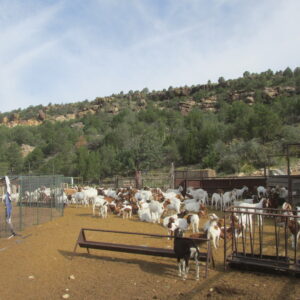
This project has explored two different methods of kidding (birthing) goats in a multi species program of grazing. Research has tracked and documented the pros/cons of Intensive kidding vs Extensive kidding programs. Intensive kidding is known to be high in labor, costs of feed and health maintenance of does and kids. This results in a lower profit margin from kid sales which threatens economic sustainability.
It is now believed an Extensive kidding method will increase the number of live kids raised from birth to sale as well as reducing labor and costs of kid goat production in and Open Range program of multi species grazing. In years 2 and 3 of this project (2023-2024) data has been collected to show that an Extensive program of kidding does out in two connected traps can reduce cost of feed, labor and result in kids that are able to follow their mothers earlier, resulting in a higher percentage of live kids surviving until market.
Please note that adult losses in both groups were due to a freak winter storm which occured first of May in 2024.
In 2024, the Intensive Kidding Pens (IKP) group started with 45 does. 4 does aborted and were turned back into open doe herd. The remaining 41 does represented 44% of the bred does in 2023. The IKP group earned a gross average of $127.53 per doe. After expenses, IKP kids earned a net average of $44.93 per head. Total feed cost for the IKP group was $3,799.00 or 66% of the total feed used in 2024. The EKP group started with 49 does but after 4 does died and 2 aborted due to a freak winter storm, the remaining 43 does represented 46% of the does bred in Dec of 2023 for 2024 kids. The EKP kids' gross average revenue was $157.22 per head. After expenses, the net earnings from the EKP group in 2024 was $125.28 per hd. Total feed cost for the EKP kids in 2024 was $1,948.00 or 34% of total feed cost for 2024. Also, 51% of the IKP kids made it to sale while 57% of the EKP kids made it to sale. It is believed this difference of live kids to market is a direct result of poor bonding within the IKP group and good bonding in the EKP group.
In 2023, the Intensive Kidding Pens (IKP) group consisted of 45 head and represented 58% of bred does in 2023. The IKP group earned a gross average of $56.04 per doe. The net revenue of kids for the IKP group averaged a loss of -1.00 per kid/head after expenses were applied. The Extensive Kidding Pasture (EKP) consisted of 32 head and represented 42% of does bred in 2023. The EKP group earned gross average of $94.14 per doe. The net revenue of the kids for the EKP group averaged $30.12 per kid/head profit. 2023 documented a positive results for the Extensive Kidding Pasture revenue vs Intensive Kidding Pasture revenue. Year 3 test kids are due to arrive in May of 2024. The results from the 2024 kidding/sales season have helped determine that the Extensive Kidding program is sustainable and results in higher revenues.
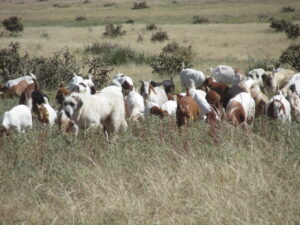
An increase in marketable kids while reducing labor and cost inputs has created a greater profit margin for a sustainable multi species grazing program. This project was designed to determine if the losses of kids, cost of feed and labor can be reduced in an Extensive kidding program. We believe it has done so. Reduction of these factors has resulted in an increase of live kids making it to market sales and which has created a greater profit margin for sustainable multi species grazing program. The pros and cons of Extensive vs Intensive kidding management have and will continue to be disseminated to the Ag community via Social Media, Multi Species Grazing workshops and rancher to rancher.
- Design and build two kidding traps adjacent to each other and a working set of pens for identifying and moving pregnant goats to kidding traps as needed.
- Document, record and rate all births possible and compare whether Intensive or Extensive kidding programs produce the greatest number of live kids.
- Track feed and labor costs of each type of kidding program to see which is the lower in cost and labor to determine total cost of production of marketable kids.
- Monitor kidding traps for soil improvement and grass restoration during non- kidding season when traps will be rested.
- Identify the best type of kidding program ranchers can adopt to create an additional sustainable source of revenue as well as improving their land. Share the information discovered through educational programs and social media presentations.
| Timeline of Project Objectives/Activities | 2022 | 2023 | 2024 | 2025 | |||||||||||||||||||||||||||||||||||
| Project Year 1 | Project Year 2 | Project Year 3 | |||||||||||||||||||||||||||||||||||||
| Activity Description | June-Aug | A-S | S-O | O-N | N-D | D-J | J-F | F-M | M-A | A-M | M-J | J-J | J-A | A-S | S-O | O-N | N-D | D-J | J-F | F-M | M-A | A-M | M-J | J-J | J-A | A-S | S-O | O-N | N-D | D-J | J-F | F-M | M-A | A-M | M-J | J-J | |||
| Objective 1: Construct traps for kidding - Breed Dec-Jan | XX | XX |
XX |
XX |
XX |
XX |
XX |
XX |
|||||||||||||||||||||||||||||||
| Move does w/30 day kids to traps Yr 1 | XX | XX | |||||||||||||||||||||||||||||||||||||
| Objective 2: Monitor does for kidding, bonding | XX | XX | XX | XX | XX | XX | XX | XX | XX | XX | |||||||||||||||||||||||||||||
| Objective 3: Quantify results of kiddings and costs | XX | XX | XX | XX | XX | XX | XX | XX | XX | XX | XX | XX | XX | XX | |||||||||||||||||||||||||
| Objective 4: Disseminate information through educational outreach | XX | XX | XX | XX | XX | XX | XX | XX | XX | XX | XX | ||||||||||||||||||||||||||||
| Progress/Final Reports | XX | XX | XX | XX | XX | XX | XX | ||||||||||||||||||||||||||||||||
Cooperators
- - Producer
- - Technical Advisor
- - Producer
Research
Objectives:
- Design and build two kidding traps adjacent to each other and a set of working pens for identifying and moving goats to kidding traps as needed in Extensive Kidding program.
- Document, record and rate all births possible and compare whether Intensive or Extensive kidding programs produce the greatest number of live kids for the lowest input.
- Track feed and labor costs of each type of kidding program to see which is the lower in cost and labor to determine total cost of production of marketable kids from each kidding program.
- Monitor kidding traps for soil improvement and grass restoration during non- kidding season when traps will be rested.
- Identify the best type of kidding program ranchers can adopt to create an additional sustainable source of revenue as well as improving their land. Share the information discovered through educational programs and social media presentations.
Materials and Methods:
Experimental Design
- Design and build two kidding traps
Two “kidding traps” were designed and constructed to help determine the advantages or disadvantages of Intensive Kidding programs vs Extensive Kidding Programs. They were constructed in a 1,000 acre pasture to be designated as the Kidding Pasture. Construction was completed March 15, 2023.
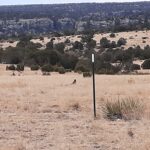
Due to major fires in Mora and San Miguel County in 2022, as well as COVID ramifications, materials and labor needed to construct fence have been in short supply. Materials were ordered in July of 2022 and finally received by September 2022. Local fence contractors were unavailable due to prior commitments for fence rebuilding in fire ravaged areas.
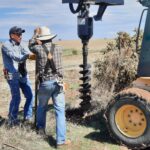
Working with the local community of ranchers, landowners and individuals interested in multi species grazing programs has allowed the project to progress toward finishing Objective One. The traps currently cover 75 acres total and be designated as Trap#1 and Trap #2. Final construction of 35 acres will begin upon final funding of project. Traps have been constructed using OK Brand premier hinge joint field fence. The fence has 10 horizontal wires spaced in variable intervals. The vertical stays are 12" apart and the fence height is 47 inches. This wire fencing covers three sides of the pasture as well as pasture divisions. It is connected to existing woven wire fence on fourth side.The existing woven wire fence is being reinforced with Electric fencing at heights suitable for kid goats.
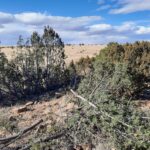
The traps are adjacent to each other with gates to allow movement of does and kids as needed. A night pen for entire herd is adjacent to kidding traps and also serves as sorting pens for movement of does nearing parturition. Net fencing used to deter predators and secure kids inside of traps was chosen to also keep goats from getting stuck in fencing. The existing 4th fence line with existing net wire was to be reinforced with 1 to 2 strands of electric fencing to discourage challenges to older fence line and help educate goats to respect electric fencing. Electric fence will be located above kid height for safety of kids. Due to drought conditions and the fact that this existing North/South running fence line was known to catch dried tumbleweeds, the infrastructure of the electric fencing was installed but never electrified. Said fence line was cleared of brush and repaired. The main problem with this fence line was the original fencing was only 6 x 6 net wire. This size of net wire is conducive to horned goats getting their heads stuck when they decide the browse on the other side of the fence line is much more appetising. Luckily, only one doe out of 77 was of that mindset. The size of 100 acres is necessary due to the fragility of NE NM lands. 250 gallon portable water tanks with attached troughs were purchased and set in place for watering in both traps. A portable 250 gal water tank was used to fill tanks in each pasture as needed.
2.Document and record all births possible and compare whether Intensive or Extensive kidding programs produce the greatest number of live kids.
Due to the delays in materials and construction of kidding pastures, we were unable to move 30 day old 2022 kids and does into kidding pasture to monitor during the months of August thru October of 2022.
2022 kids were all born in intensive kidding program. Does along with their 2022 kids that were born in May and were moved to pasture in August at 60 to 90 days old. Upon release into pasture, all goats were herded to encourage cohesiveness of herd and encourage kids to follow their mothers and the herd. The 2022 kid crop is going to sale after this report is due so data from the 2021 kid crop is being supplied for this report in charts and spreadsheets.
Kidding season two (April 2023), 35% of bred K&C Does were entered into the EKP program. 58% of bred Does were entered into the IKP program. The 1st of April, the EKP group was moved into 10 acre kidding trap #1. Traps were checked twice daily to check for birthing problems or bonding issues. Any problems will be either put into jugs for bonding or will result in the kids being put on bottles and the does moved back to the open doe herd. While Evaluation Sheets to collect information on kids as they are born and grow were developed, most birthing info and problems were collected in daily notebooks to be transferred to Kid Eval sheet WSARE 2022. EKP does stayed in Trap #1 until their kids were 30 to 45 days old. They were then moved to trap Trap #2 where they were combined with the IKP does and kids (30 to 45 days old) for bonding of herd and to observe bonding of kids to does in from each program. After approximately 30 days in Trap #2, IKP and EKP kids and their mothers were turned out daily into the 1,000 acre kidding pasture. There they were observed (with very little intervention) for bonding of kids and cohesiveness of herd. In 2023, it was observed that there was a 100% improvement in kids following and keeping up with their mothers and the herd staying in one cohesive group.
At 30 - 45 days old, IKP does and kids were moved to Trap #2 to encourage bonding of entire herd. EKP kids were tagged with special ID tags for easy identification through bonding process and for future sales information. After 30 days in Trap #2, both groups were released as one herd back into Kidding Pasture and observed for cohesiveness. Minimal interventional herding was used.
In year three (2024) 41 does (44%) remained in Intensive Kidding program. The IKP does were placed into a 2 acre corral with existing shelter and barn approximately 2 weeks before their due date. Does kidded in corrals and any problems identified were addressed. Bonding problems will resulted in does and their kids being put into small pens (jugs) to ensure health and safety of kids and encourage bonding process. Each doe entered in each of the programs was listed and documented for potential birthing problems and bonding problems. As kids were born in the IKP program, they were tagged with mother’s ID and individual white or green ID tags. Kids were then listed in same program as mothers. Their time to get up and nursing was noted and recorded as well as their general health and strength and ability to follow their moms. The kids born in the EKP pastures were not tagged with mother's ID' and only tagged in June when kids and does from the EKP pastures were dewormed, ID tagged, vaccinated and males castrated. The ID tags were listed in workday listings and assigned to the EKP pasture data being tracked.
The documentation of live kids tagged, turned out and subsequently making it to sale was also added to data collected. Kids from respective programs have been tracked from birth to sale for each year of project. Points of comparison in 2024 were documented via photos and video as well as notes taken throughout the 2024 year until the kids made it to sale. In each year, both IKP and EKP groups were combined to create cohesion in herd and note the differences in bonding between the IKP and EKP kids and their mothers. After 45 days in the 65 acre pasture, this combined group was turned out to be herded in the 1,000 ac pasture for an additional 30 to 45 days before moving complete herd down to Canyon pastures.
In Dec of 2024, does were bred for kidding in May of 2025. 15 does were left in the IKP group while the remaining does were put in EKP pastures to kid for 2025. Real life scenario was adopted and does were checked daily for any problems to arise. An early May storm hit the area with 3 days of cold rain, hail and strong winds. 5 does in the EKP died from exposure, and 2 aborted before due dates. Kids in this group were born mid May thru first of June. Number of kids will be identified in mid August when herd will be worked for ID tagging of kids, deworming, vaccinations and castration. It is interesting to note that only 6 bottle babies were created from this group. Three groups of triplets were born and the smallest of the group is always pulled for bottle feeding. The other three were due to abandonment from 1st time mothers. 8 kids died from the group due to mother's neglect and pneumonia. It has been decided to construct portable A frame shelters for future use in 10 acre pasture to help avoid deaths from inclement weather.
3. Determine total cost of production of marketable kids
The 2022 kid crop had not gone to sale as of this 2022 first report but all costs have been tracked and documented. 2021 kid crop was raised in Intensive kidding program and data on all feed costs and labor inputs plus live kids sold, kept or died/lost have been tracked. This data is shown in attached charts and spread sheets. Value of 2021 kid crop. Avg cost vs exp WSARE 2022. Total Income vs Exp WSARE 2022
Work sheets have been developed for each kidding program to track feed, medical costs. Feed usage WSARE 2022 Bonding issues, general health, well-being of kids and does are reported in Kid Evaluation sheets (above) and daily notes from observations. Final market numbers were determined at final sales of yearly kid crops. This will enable us to determine which program results in more marketable kids and the lowest input of resources possible. Videos and photos will also be taken and used for future educational material as well as social media presentations.
The 2023 kids crop has given this project positive data regarding the total cost of production of marketable kids. Revenues and expenses were recorded for IKP and EKP programs. Numbers and ratios of does to kid revenues for each type of kidding program has been recorded with results listed below in Research results and discussion. Net revenue per doe and number of live kids making it to market are also been identified below.
The 2024 kid crop gave this project positive data regarding the total cost of production of marketable kids. The IKP group feed cost per kid was $82.60 while the revenue per kid was $127.53. That gave the IKP kids a profit of $44.93 per head. Better than the losses of 2023, but still lower than the EKP group. The EKP group feed cost per kid was $31.94 while the revenue per kid was $157.22. That gave the EKP kids a profit of $125.28 for 2024.
4. Monitor kidding traps
Kidding traps and kidding pasture will be monitored for soil improvement and grass restoration during non-kidding season. Set points are have been established with attention to terrain for before, during and after kidding season photos. These will be compared with set points outside kidding pasture. Goats were fed a modified version of hay bale grazing while in traps. Photos of set points before kidding season and after have been taken for demonstration purposes and future educational materials. Final determinations/results will be reported in year 3's final report.
Each year of project, goats in kidding pastures were fed hay every 3 to 5 days. The hay was set out in modified hay bale feeding where the hay was distributed over stressed and fragile areas of the pastures. After 3 years of this process, it was noted that pastures improved. This can be seen in the PPP of objective 4 attached below. Pictures from 2023 and 2025 were taken in critical areas and note the improvements. It has been determined that feeding hay over stressed and fragile areas each year and resting the pasture for 9 mos enables the kidding pastures to remain in sustainable.
5. Identify ways in which ranchers can adopt the use of goats for multi species grazing and benefit from Intensive or Extensive Kidding Programs.
Using the research from this program as well as the previous WSARE funded project, “The use of goat herding techniques to reduce the effects of predation while improving rangeland health in the high plains of New Mexico”, the best techniques for re-introducing goats into a multi species grazing program will be disseminated as described in the educational outreach plan below.
Research results to date for objective 1 have were hard won. Delays were encountered due to local fires, material and labor shortages, weather and other seasonal projects with the cattle. Materials were ordered as soon as project funding became available but took 4 months to receive. By the time materials were received, fence contractors whom bids were initially received from, were committed to projects rebuilding fences destroyed by the Calf Canyon/Hermit's Peak fires of Mora and San Miguel counties. Local ranch employees were then hired to help start the fencing project. Fall cattle projects then came into play and fence building hit the back burner. Then winter weather came into play and further delays were encountered. As soon as weather allowed, local youths were hired to clear existing back fence lines. These fences were 80 yrs old and completely overgrown.

As weather permitted, local ranchers, goat raisers and individuals interested in learning more about goats in multi species grazing programs joined in to help. Work weekends were created to help complete the fence building objective.
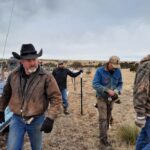
Local ranchers from Daniels Ranch, Sol Ranch, and Ft. Union Ranch joined Turner Ranches to learn more about net wire fence construction and multi species grazing operations. Besides the local ranchers, individuals raising goats locally, and those who were interested in starting their own multi species grazing programs joined to help. We even received help from past Quivira Interns who were interested in starting a prescriptive grazing service. Despite the weather, in three work weekends, the job was completed March 2023. Goats have been moved into kidding pastures each March or April depending on due dates for kidding.
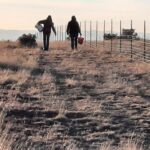
Objective 2, the documentation, recording and rating of all births to compare Intensive vs Extensive kidding was not able to be completed for the 2022 kid crop as the 2022 kid crop had not been sold as of the 2023 reporting date. The data from the 2023 kid crop is being included in this year report. The data retrieved from the 2021 kid crop is being used to determine the number of kids from the 2021 (Intensive Kidding) kid crop that made it to market, the numbers kept and the numbers lost to either sickness or predation.
In 2021, 125 kids were born out of 92 does. That was a 125% production rate from does. Many of these does were first time birthings so only singles were produced. They were born beginning in March 2021 thru May 2021. These kids were tracked from birth to sale in March 2022. Of the 125 kids produced, 65% (81hd) made it to sale. 12% (15hd) of the 2021 doelings were kept for replacements and 23% (29hd) of the kid crop were lost. Of the 23% of kids lost, 62% (18 hd) were killed and 38% (11 hd) died from illness. Value of 2021 kid crop. The average value was determined to be $128/kid. When comparing the average expenses for does and kids, the following chart shows the costs of kids, the cost of does and the sales income received from the sale of the 2021 kid crop.Avg cost vs exp WSARE 2022. This graph shows that while the average cost of raising each kid is covered by the average sales price of each kid, the combined expenses for does and kids kept in confinement is not covered by the average sales price of each kid. This is mainly due to the high costs of feed necessary for an Intensive Kidding program.Total Income vs Exp WSARE 2022.
In 2022, K&C had 104 (including breedable does, bucks and yearling replacement does) head of BoerX open range goats. Out of that 104, 92 were breeding age does. Out of the 92 breeding age does, 77 (roughly 74%) bred for 2023 kids. As of 4/1/23, 45 (58%) does were entered in the Intensive Kidding Pens with the remaining 32 (42%) does being entered in the Extensive Kidding Pasture. The IKP group produced 57 births with 56% making it to auctions; 19% were kept as replacement doelings; 13% were problem births and put on bottles and 12% died after birth. The deaths in this group were mainly due to illness or suffocation (due to late spring snow). The EKP group, 44 births were recorded with 59% of them making it to auctions; 16% were kept as replacement doelings; 9% were problem births and put on bottles and 16% died after birth, mainly from suffocation due to late spring snow. Those kids were under 1 month old. It was noted that kids in the IKP group needed medications to overcome illnesses while the EKP group received no medications due to lack of illness in the EKP group. Both groups of kids were de-wormed and vaccinated equally. It was also noted that the EKP group had a slightly higher percentage of kids make it to sale than the IKP kids. Kids were given ID tags representative of their kidding group for ease of tracking and future revenue results. This resulted in the IKP group (57 head of does) having a 127% production rate of which 89% were either sold or kept as replacements. The EKP group (32 head of does) had a 138% production rate in which 84% were either sold or kept as replacements. The IKP group had greater problem births resulting in 14% of their kids being put on bottle. The EKP group only had 4 problem births resulting in 9% of their kids being put on bottle. The IKP group of kids earned $3,194 for the year or an average of $99.81 gross per kid. The EKP group of kids earned $3,012.5 for the year or an average of $115.87 gross per kid. The results show that the IKP does earned roughly $56.04 per doe while the EKP does earned roughly $94.14/doe. Again, in 2023, the kids marketed from the EKP group totaled 59% of EKP kids produced. The IKP # of kids marketed totaled 56% of kids produced. Gross revenues per head for the EKP kids was 16% (at $115.87) greater than for the IKP does and kids (at $99.81).
IKP kids born 2023, Extensive kids chart 2023,Ext Past kidding production 2023, 2023 revenue from kids, Expenses on 2023 kids, Rev less Exp 2023 kids v2
In mid December of 2023, 3 bucks were turned out with 114 does. Of those, 94 bred and 20 yearling doelings were left open. 45 (49%) of the bred does were entered into the IKP group for 2024 kidding season. Of those 45 hd, 4 does aborted (first time mother and severe winter storm) leaving only 41 hd to kid out. Those 41 does produced 51 kids (121% production rate). Of those 51 kids, 5 died (3 before combining herds and 2 lost in terrain after moving to Canyon pastures. Of the remaining 46 hd of IKP kids, 26 wethers were sent to market and 20 doelings were kept as replacement doelings. The 26 wethers earned an average of $127.53 per hd for a total gross revenue of $3,316.00 for the group of 26 hd sold. After feed expe nses were taken out, the IKP kids made a net of $44.93 per kid. The 41 does produced 38% of the total net revenue for 2024. Of the 2024 kids produced in IKP group, 51% went to market and 39% were kept for breeding in December 2024 for May 2025 kidding.
The EKP group had 49 (hd of does initially put into the Kidding Pastures). The EKP group lost 6 does from abortion and death due to weather from the group. The does who aborted or were open were moved to the outside herd. The 43 does left to kid out produced 69 kids (161% production rate). Of the 69 kids born, 8 were lost to an unexpected severe weather event leaving 61 live kids. Of the 61 kids, 35 wethers were sold at market and 23 doelings were kept for replacement doelings. The 35 EKP wethers sold for $5,502.58 for an average of $157.22 per hd. After feed expenses were taken out, the EKP kids made a net of $125.28 per kid. The 43 EKP does produced 62% of the total revenue for 2024 as well as producing 23 doelings that were kept for replacements for breeding in December of 2024 to produce 2025 kids. Of the 2024 kids produced in the EKP group, 57% went to sale and 38% were kept as replacement doelings for breeding in December 2024 for kidding of does in May 2025. The fact that 51% of the IKP kids made it to market and 57% of the EKP kids made it to market shows that kidding in pasture does not greatly affect the live market number of EKP kids available for sale.
Data for Objective 3. The tracking of feed and labor costs of each type of kidding program was determined for the 2021 Intensive kidding crop. This average expense was determined using cost of goat feed only. Feed Exp goats dogs WSARE 2022. We know, that due to the increasing cost of feed and hay these numbers increased in 2022. Just hay for 2023 expenses will see a minimum of a 28% increase according to recent calls for hay($250/ton in 2022 vs current costs of $320/ton). Feed for Livestock Guardian Dogs was not included in computation. It takes roughly 18 kids goats to pay for the yearly feed expense for 11 Livestock Guarding Dogs. These dogs more than earn their keep as we see increases in predators in our local ranching communities. Coyotes were previously seen running as individuals and currently, packs of 8 to 10 coyotes have been identified as running in packs locally. Feed Exp goats dogs WSARE 2022.
The 2023 feed costs between 4/1/23 were based on hay usage only to determine difference in usage between IKP and EKP groups. Cake was fed equally between both groups so it was not included.
Starting 3/15/23, ten bales of Sanfoin/grass hay ($210/bale), 6 bales of Triticale hay ($85/bale) and 58% of 3 bales of an additional bales of Sanfoin grass hay were fed to the IKP group. These were 3/4/8 bales and were fed at a rate of 1/2 bale per day. The cost of hay for the IKP group averaged out to $2,975 in hay spent on the IKP group between 3/15/23 and 6/15/23. On 6/15/23 the combined groups were sent out to graze in 1,000 acre pasture. The EKP group, between 4/1/23 and 6/15/23 (again at turnout to 1,000 acre pasture) was fed 5 Sanfoin hay ($1,050); 3 Triticale bales of hay ($255) then 42% of an additional 3 bales of Sanfoin hay (264.60) for a total cost of roughly $1,570. Medicines were only used on the IKP group of kids for illnesses. There were no illnesses noted in the EKP group of kids. Kids from both groups were also de-wormed and vaccinated. Total cost for the IKP group was $2975 feed + $270 meds/wormer/vacc. Total expenses for IKP kids was $3,245. Total revenue for IKP kids was $3,194. That results in a loss of $51 or $1.00 per head deficit. Total expenses for EKP group was $1,570 + $117.45 in de-wormers and vaccines for a total expense of approximately $1,688. Total revenue for EKP kids was $3,013 less total expense of $1,688 resulting in a $1,325 yearly profit or $30.12 profit per head on kids. These numbers reflect the possibility for an Extensive Kidding Program to create a sustainable kidding program for multi-species grazing operation
In 2024, total cost of feed for the IKP group was $3,799.00 resulting in a per hd cost of $82.60. The revenue for the IKP group was $127.53 giving the IKP kids a profit of $44.93 per head.
2024 total feed cost for the EKP group was $1,948.00 resulting in a per hd cost of $31.94. Revenue for the EKP group was $157.22 which gave a profit per hd of $125.28. The profit for the EKP group was 279% greater than the profits for the IKP group.
Objective 4 research, monitoring kidding traps for soil improvement and grass restoration, was conducted all 3 years of project. We identify the best locations, due to terrain, to set monitoring locations inside and outside of traps. Attention to water drainage and soil was evaluated for best placement of monitoring spots. Each year of project, goats in kidding pastures were fed hay every 3 to 5 days. The hay was set out in modified hay bale feeding where the hay was distributed over stressed and fragile areas of the pastures. After 3 years of this process, it was noted that pastures improved. This can be seen in the PPP of objective 4 attached below. Pictures from 2023 and 2025 were taken in critical areas and note the improvements. It has been determined that feeding hay over stressed and fragile areas each year and resting the pasture for 9 mos enables the kidding pastures to remain in sustainable.
In 2023, t-posts were set up for monitoring the results of hay bale grazing. Triticale hay, Alfalfa hay and Sanfoin/grass hay were all three used to determine which hay offered the greatest retention of moisture, deposit of organic matter and opportunity for pasture re-growth when not in use for Extensive Kidding Program. It was determined that the best hay to deposit litter and organic material was the Triticale (which is a semi cane hay). The areas of bale feeding are marked and will be monitored throughout the project. Resulting data will be disseminated in final project report. In yr 3, 2024, no Triticale hay was used. Instead a Grass/Alfalfa or Grass/Sanfoin hay was used for feeding. The grass combinations did better at covering stressed grounds and being utilized by does and kids.
Objective 5 activities, the identification of the best type of kidding program ranchers can adopt is has been researched for 4 years (2022, 2023, 2024 and 2025) and determinations to date are being shared through one on one activities with local ranches and individuals interested in multi species grazing operations. A Facebook page has been developed with connections to many restorative grazing groups and other interested parties to share the journey of this project. Also, Power Point presentations have been developed and have been distributed as they are created to interested individuals and groups.
As of 2023, the preferred type of kidding program looked to be the Extensive Kidding Program. During 2023, 3 workshops were held for ranchers, farmers and other individuals interested in starting a Prescriptive Grazing Service in Taos, NM and West Pueblo, Colorado. Two of the workshops were workdays consisting of hands-on working of the goats and kids from each perspective group. Handouts were available at 1 of the workdays and the workshop. The handouts consisted of goat care information as well as a printed out version of the WSARE 2022 Power Point Presentation submitted with the 2022 report. Evaluation sheets were handed out and filled by participants. Multiple email correspondence was included in the outreach consultations for interested parties. It is of great interest at the number of people interested in starting Prescriptive Grazing Services in Taos, NM and West Pueblo, CO. Workshop included discussions on funding opportunities for beginning Farmers and Ranchers thru the USDA.
In 2024, 2 workshops were again held for individuals interested in maintaining a multi species grazing program. Goat health, reproduction and info on grazing were shared. In 2025, the final report was made showing research has determined that the best kidding program for multi species grazing programs was the Extensive Kidding Pasture program. This research and information has been made available through two Youtube videos set to go public August 1, 2025. The final report can be viewed at https://youtu.be/3kLsaoCy32g . The video on Objective 4 - pasture monitoring and improvement can be viewed at hhttps://youtu.be/LA7YOzCOG_E. These two Youtube videos will also be made available to interested parties thru K&C Boer Goats Face Book Page. Copies of MP4s will be also sent to regenerative ranching facebook pages and other interested non profit organizations. We are currently looking into joining the Quivira Coalition's yearly meeting in November for presentation opportunities. Many members of the Quivira Coalition have voiced desire for more information on regenerative pasture practices and shown interest in the projects WSARE, K&C Boer Goats and Turner Ranch have done. We look forward to sharing the results of these projects.
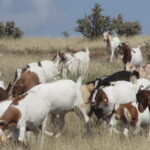
Research outcomes
In 2025, the final outcome of the 2024 kid sales determined that for a Multi species grazing program to be used in NE NM, the adoption of the Extensive Kidding Pastures was the most beneficial for sustainability and profitability. The reduction of cost of production and the increase of bonding and herd cohesion resulted in more live kids making it to market sales.
In 2024, total cost of feed for the IKP group was $3,799.00 resulting in a per hd cost of $82.60. The revenue for the IKP group was $127.53 giving the IKP kids a profit of $44.93 per head.
2024 total feed cost for the EKP group was $1,948.00 resulting in a per hd cost of $31.94. Revenue for the EKP group was $157.22 which gave a profit per hd of $125.28. The profit for the EKP group was 279% greater than the profits for the IKP group.
Research as of March, 2023 on this project consisted of the designing and construction of kidding traps and recording/evaluation of revenue vs expenses for 2021 kid crop raised in Intensive Kidding program. The 2022 kid crop expenses were recorded and evaluated in 2023 after final revenue receipts for 2022 kid crop were received. Said kid crop was sold mid to late March depending on market reviews. Research conducted has determined Extensive kidding practices are most suitable for a sustainable multi species grazing program. Revenues vs expenses for all kid crops researched during this project have been used in this determination.
Due to major fires in Mora and San Miguel counties in 2022, along with shortage caused by COVID restrictions, materials and labor availability have been in short supply. This caused delays in construction for Objective 1. Materials ordered in July of 2022 were not received until end of August 2022. At that point, local fencing companies were contracted out to jobs in fire ravaged Mora and San Miguel counties. While contracting professionals for the job you need doing is advisable, it has worked out more than once that your local community and neighbors will come through in a pinch. Working within your community, whether they are skilled or not, brings about opportunities for education and comradery (as well as great meals and memories). By using work weekends for education and sharing of knowledge, we were able to continue to meet our objectives. Meetings during work weekends, social media announcements, and One-on-One outreach within the ranching community (and interested land owner and individuals as well) offers opportunities for connecting and growth. Presentations sent to interested organizations have also been utilized towards fulfilling the educational outreach plan.
Results obtained from 2021 kid crop expenses and revenues show a low profit margin for large (over 100 hd) Intensive Kidding programs. Numbers of goats needed to effectively create a multi species grazing program for large open range pasture/land improvement as well as additional marketing income need to be 100 head or more. The feed costs and labor cost are high and live kids to market numbers are low in Intensive Kidding programs for large numbers of goats. The kids pay for themselves but the margin of profit for the kids does not cover the cost of containment for the Does in K&C's Intensive kidding program. The results of this research to date is based on feed prices from 2021. Prices on alfalfa cow hay alone have increased 28% from $250/ton to $320/ton current quotes. This is for 3x4x8 bales of striped alfalfa.
With the cost of feed increasing faster than the revenue received from kid crop sales, any profit is now questionable in an Intensive Kidding program for a successful multi species grazing operations. Continued research for the 2023 kid crop raised in an Extensive kidding program will help determine the best program to use to reduce costs while increasing revenue and profit margins.
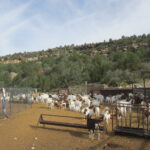
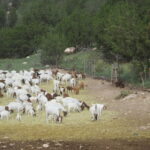
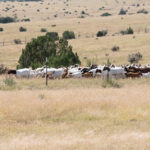
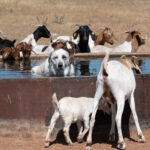
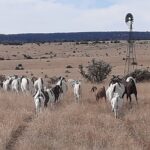
Results from the 2023 kid crop sales have been encouraging. Does entered in the Intensive Kidding Project (45) produced 45% (57) of total 2023 kid crop (101 kids) and generated 53% of the total revenues. The IKP group also generated 66% ($3,245) of the total 2023 expenses. When finding the net revenues for the IKP group of kids, the net revenues for said kids was a negative $51.00. This averaged to a loss of $1.00 per kid.
Does entered into the Extensive Kidding Project (32) produced 44% (44) of the total 2023 kid crop and generated 49% of the total revenues. The EKP group also generated 34% of the total expenses for 2023. The net revenue for the EKP kids averaged $30.12 per head. As projected in 2022, feed prices rose. Striped Alfalfa hay rose from $210/ton to $250/ton. Shipping cost of feed and livestock also increased with the prices of Diesel going up. The data collected from 2023's kid crop numbers indicate that the Extensive Kidding Program could be sustainable. Yet, there are other factors included in determining which kidding program will result in the most sustainable revenue, the main one being weather. Year 3's research, the 2024 kid crop will be born in mid-May and resulting data will give a better idea of how all the factors come into play to encourage or threaten the sustainability of multi-species grazing programs in NE New Mexico.
Education and Outreach
Participation summary:
As of March 2023, the first objective of designing and creating a kidding pasture with 2 kidding traps has been met. The methods used in sharing the information gained from objective one have been in the form of three impromptu work weekends, one on one sharing, social media postings and power point presentations sent to interested organizations. While many participants were familiar with building 5 strand barbed wire fencing, only 1 person (out of 11 people attending work weekends) was vaguely familiar with net wire installation. Through hands on learning, sharing of knowledge of goats in multi species grazing operations and the type of fencing needed a community of learners was created. Participants included Daniels Ranch of Wagon Mound, NM; Sol Ranch of Wagon Mound, NM; Ft. Union Ranch of Watrous, NM; Tucker Ranch of Watrous, NM; local residents interested in the aspects of multi species grazing and individuals interested in creating future prescriptive grazing services for ranches as a business. The weather, especially the wind, was tough, but the stead fast heart of those in agriculture kept the project going through the cold and wind. Through the dedication of this community of ranchers and individuals in agriculture, objective one was completed and knowledge shared (along with some good mid-day meals)!
In 2023, three workshop/workdays were held. First workday was May 21 and was held to prepare does and kids for move to Extensive Kidding Pasture #2. Does and kids from IKP were de-wormed, vaccinated and kids were tagged with individual ID tags. Does and kids in the EKP were also de-wormed, vaccinated and tagged with individual ID tags that were unique to the EKP program. This seperate ID system was used to easily identify IKP kids from EKP for future behaviour and sales. Does and kids from IKP were later moved to 65 acre Trap #2 and all groups were merged together. This workday included ranchers from Sol Ranch, Tucker Ranch and individual members of the community who were interested in using multi-species grazing in their operations. In November, a workshop was held for a group of people from Taos, NM who were interested in learning more about goats to start their own Prescriptive Grazing Service in the Taos area. On December 2, a third workday was held and members of a group from West Pueblo, Colorado participated along with local ranches. The group in Colorado is also interested in starting a Prescriptive Grazing Service in the areas around West Pueblo, CO. All three workshops were day long and include handouts and on hands, on the ground activities. Of the 3 workshops/workdays, 7 written surveys were returned. 4 from the November workshop and 3 from the December workshop. Other workdays were attended by individuals who have been attending our workdays here at Turner ranch for 3 years. A response of "yes" answers on the received surveys and continued attendance is a positive reflection of the desire of local ranches, producers and service providers to learn how to incorporate the use of small ruminants into multi-species and prescriptive grazing services. 11-23 workshop cover .
In 2024, two additional workshops were conducted regarding herd health, reproduction and management. Up to date results of the project were discussed and a hands on application of health management practices were presented. In the final kidding year, (2025) a more realistic approach was used in monitoring herd production and dynamics. Does in the EKP program were only monitored daily to address any problems and feed hay as needed. 2025 kids will be counted and ID's in August of 2025. Cost and revenue will again be recorded in 2025 kid sales to confirm the use of Extensive Kidding Programs give sustainable results.
With the final report in July of 2025, a MP4 video was created encompassing entire project from 2022 thru 2025. This video has been uploaded to Youtube and can be accessed at https://youtu.be/3kLsaoCy32g . Also, the results of Objective 4, the monitoring and assessment of the kidding pasture has been recorded in another MP4 video posted to Youtube and can be viewed at https://youtu.be/LA7YOzCOG_E .
In early 2025, K&C Boer Goats received requests from individuals associated with regenerative grazing organizations for information on the results of this project and another WSARE project conducted in 2018 thru 2020. That project addressed the issues of predation in small ruminant herds in NE NM. K&C Boer Goats is currently researching the option of presenting the results of both projects at the 2025 Quivira Symposium held in November of each year.
Objective one, the building of two kidding traps with a combined acreage of 100 +/- acres was completed and knowledge was share over 3 weekends with 11 local ranchers and individuals interested in goats and multi species grazing programs. Completion of objective one was delayed due to material and labor shortages as well as weather and seasonal cattle operation needs. Pens are now ready to populate with big bellied does ready for kidding season to begin.
In 2022, 2023 and 2024, objective 2 (Document and record all births) was met proving the Extensive Kidding Pasture program is best suited for multi species grazing operation in NE NM. The production of live kids to market increased every year this program was in use as a result of better bonding of kids and does within the EKP group. This increase of live kids to market will help enable sustainability of a multi species grazing program. As of June 30, 2025, the data collected indicates that the Extensive Kidding Program will result in greater profits and less losses of kids.
Objective 3 (Track costs of each type of kidding program to determine total expenses incurred to produce a marketable kid) was achieved thru the collection of feed used, birthing data, % of live kids reaching market and the revenues each kidding program produced, both gross and net. This information encompassed 2022, 2023, 2024 and 2025. It shows that the use of pasture kidding over pen kidding reduced kidding costs immensibly. Lower cost results in higher profit margin per kid which also indicates the Extensive Kidding Program will result in greater sustainability for multi species kidding programs.
Objective 4 has been completed and shows the feeding of hay in stressed and fragile areas of the kidding pastures ensures the sustainability of said pastures. Marker t-posts were to determine the impact hay bale grazing has on the regenerative properties of the kidding pasture lands and hay bales were fed. Stressed area and areas of erosion and sparse vegetation healed and improved over the 3 year program. The increase of vegetation in many areas was amazing and even though hit hard during kidding pasture use, it was able to regenerate for use the following years.
Objective 5 has been addressed by creating Youtube videos, Power Point Presentations and Workshops to disseminate projects findings. Future educational opportunities will be addressed through offering many Regenerative Grazing Organizations opportunities to share the results of this and other projects conducted by WSARE, K&C Boer Goats and Turner Ranches.
At this point, the research conducted through WSARE #FW22-403 conclusively shows that the most kids to market for the lowest expense is obtained through the Extensive Kidding Pasture use. The main detrimental factor in using EKP in the kidding operations in open range is the lack of shelter and the uncertainty of weather conditions currently being experienced globally. This will be addressed through the construction of multiple portable A frame shelters. With this adjustment, the use of Extensive Kidding Pastures should offer continuing opportunities for successful kidding practices in multi species grazing programs in NE New Mexico. The projected kidding dates have also been moved back to May for future kidding seasons.
Education and Outreach Outcomes
As of March 2024, Tucker Ranch has adopted the Extensive Kidding program in their operations and 2 individuals are working on starting new Prescriptive Grazing Services; one in Taos, NM and one in West Pueblo, Co.
Goat reproduction and behaviour.